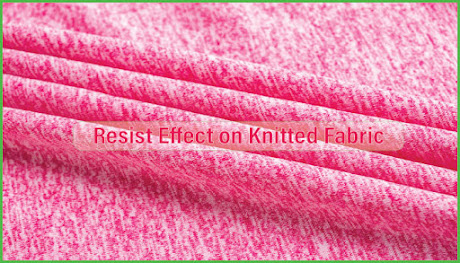Dyeing of PC blended Fabric with Disperse Dye to Produce Resist Effect
Last updated on July 17th, 2023 at 10:47 pm
Blended fabric is a collection of many artists work mixture of styles and a celebration of talent. Blends are any textile materials from fibres through yarn to fabric which are deliberate combinations of chemically or physically fibrous polymer. Under this definition, blends can range from bi-component fibres, mixture of different filament core spun yarn, uniformly blended staple fibre throughout fabric and everything which falls between.
Resist or Reserve Dyeing with Blends
At least one of the components of the blend remains essentially un-dyed i.e. almost white. Example: milens fabric, here in resists dyeing – cotton part remain un-dyed.
Fibre and Fabric
Fibre: Cotton and Polyester
Fabric: Knitted
Dyes
Any class of disperse dye. Slightly water soluble. They are made soluble with the help of some dispersing agent. Colorfastness of this dye is excellent. It gives a variety of shade.
Instruments and Glass Wares
- Beaker
- Glass rod
- Measuring rod
- Bowl
- Electronic balance
- Scissor
- Sample dyeing machine
- Pipette
- Conical flask etc.
Dyeing of Polyester Part
Recipe
- Disperse red: 2%
- Dispersing agent: 1g/l
- Acetic acid: 1g/l
- Sample: 1 : 20
- Total liquor: 100
- PH: 4.0 to 4.5
Chemicals and auxiliaries
- Acid
- Dispersing agent
- Leveling agent
- Buffer solution
Necessary Calculation
We know required dye in CC = (Sample wt. X shade %)/( Stock solution %)
Disperse red: 1% stock solution = (5 X 2%)/1% = 10CC
Required chemical in CC = (gm/l X Total liquor)/(stock solution%)
Dispersing agent: 1% stock solution = (1 X 100 X 100)/1000 = 10CC
Procedure
Dye bath is set at 50-600C with buffering solution for maintaining PH 4 – 4.5. dispersing agents are applied in two stages. First half with dye solution. Rest half in the dye bath with fabric. Then the temperature is raised to 85 – 95% by 3 gradients. PH is checked here if there is any fluctuation then it is adjusted by buffer solution. Now raise the temperature to 1300C by 1.5 – 2 0C/min. Keep the entire bath running at 1300C for 30 – 60 minute depending upon the required depth of shade. Temperature is down by cooling 800C.
Neutralization
Recipe
Acetic acid: 1gm/l
Calculation
Acid: 1% stock solution = (1 X 100 X 100)/(1000 X 1) = 10CC
Water required = (1000 – 10)CC = 90CC
Procedure
Neutralization is done to remove alkali from the fabric. 1gm/l acetic acid is used. Then treat the sample at 400C for 10 minutes.
Precautions
- Stock solution should be prepared carefully.
- Time and temperature should be properly maintained.
- Neutralization should be done properly.






Dyeing on fibrous polymers may require certain steps to follow. The type of dye will define much for the results. In this instant, color fastness with other features is a key point to getting the good results.